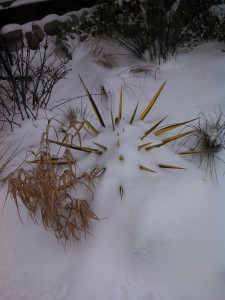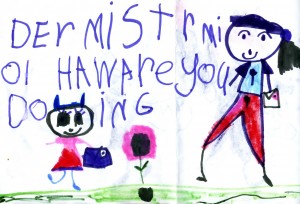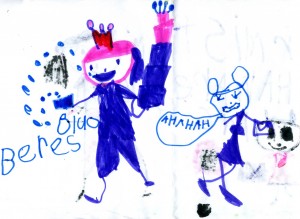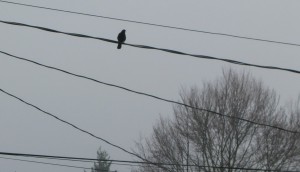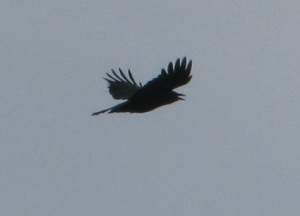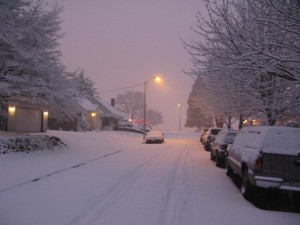 As I hand him his mail, Mike Salvo waves up to the crows perched on the telephone wires, and says: “When they sit there like that, waiting, you know that the worst of the storm is yet to come. When they are flying around, that’s when you know the storm has broken.” Its day 3 of the so-called Snowpocalypse 2014, alluding to Portland’s collective chuckle at this winter weather that would seem mild to anyone from Montana to Maine but has shut down our schools and most businesses. Celebrating their unexpected “free day”, neighbors avoid cabin fever by heading to the businesses that are open. Mock’s Tavern, Christies and University Grill are chockablock with people who traversed the eight inch blanket of snow thanks to boots, snowshoes, or cross country skies, watching the big screen TV while awaiting omelets and hash browns or burgers and fries, talking a mile a minute, glancing with delight at the steady snow falling while they are cozy warm here inside, and occasionally noticing the Weather Channel’s scrolling text announcing freezing rain predicted for Sunday. But for now, its a party. With such a crowd, I was later told University Grill had to close early, after completely running out of food. In contrast, twenty or so Song Sparrows are having their own feast, feeding on the bounty of a Holly tree at the corner of Fiske and Princeton, chirping their delight at their berry banquet.
As I hand him his mail, Mike Salvo waves up to the crows perched on the telephone wires, and says: “When they sit there like that, waiting, you know that the worst of the storm is yet to come. When they are flying around, that’s when you know the storm has broken.” Its day 3 of the so-called Snowpocalypse 2014, alluding to Portland’s collective chuckle at this winter weather that would seem mild to anyone from Montana to Maine but has shut down our schools and most businesses. Celebrating their unexpected “free day”, neighbors avoid cabin fever by heading to the businesses that are open. Mock’s Tavern, Christies and University Grill are chockablock with people who traversed the eight inch blanket of snow thanks to boots, snowshoes, or cross country skies, watching the big screen TV while awaiting omelets and hash browns or burgers and fries, talking a mile a minute, glancing with delight at the steady snow falling while they are cozy warm here inside, and occasionally noticing the Weather Channel’s scrolling text announcing freezing rain predicted for Sunday. But for now, its a party. With such a crowd, I was later told University Grill had to close early, after completely running out of food. In contrast, twenty or so Song Sparrows are having their own feast, feeding on the bounty of a Holly tree at the corner of Fiske and Princeton, chirping their delight at their berry banquet.
Meanwhile, letter carriers are not so much “pounding the pavement” as pushing thru the wind, aligning steps in the trenches left by car tires, reluctantly cutting thru dry packed snow covered driveways and sidewalks, edging up porch stairs blanketed in snow drifts. Its hard to appreciate the irony that, with hazardous Winter weather conditions causing the grounding of the planes, therefore shutting down the mail flow, letter carriers are required to deliver less mail in far more dangerous circumstances. Despite the fact that, by City Code, property owners are responsible for removing snow, ice and slippery leaves from their sidewalks and driveways, very few attend to this requirement. They are liable for personal injury caused by failing to remove the snow and ice on their property but very few realize this. When faced by a snow drift covering your porch stairs, a letter carrier is going to stuff that Victoria Secret catalog and dentist appointment reminder in the satchel for delivery on another day. And then slog through the snow banks to the next house, hoping for shoveled stairs.
I mostly blame Ben Franklin for this….in the worst weather, we are expected to deliver the most unnecessary mail imaginable. All thanks to the dictum, stated by Ben when appointed the first U.S. Postmaster General: “Neither snow nor rain nor heat nor gloom of night stays these couriers from the swift completion of their appointed rounds.” It derives from a quote from Herodotus’ Histories, referring to the courier service of the ancient Persian Empire. Ben Franklin thought that was an appropriate creed for the new colony’s burgeoning postal service. Whatever was he thinking.
“It is said that as many days as there are in the whole journey, so many are the men and horses that stand along the road, each horse and man at the interval of a day’s journey; and these are stayed neither by snow nor rain nor heat nor darkness from accomplishing their appointed course with all speed.”
—Herodotus, Histories (8.98) (trans. A.D. Godley, 1924)
It is what it is, and we do what we can and some appreciate that. I had 2 people offer to make me hot chocolate, and a dozen others who thanked me for all that I do.
By afternoon, there were sleds, snow saucers and boogie boards pulled out of garages and attics, and kids and families headed to the Arbor Lodge side of Mock’s Crest and the newly renovated Waud’s Bluff Trail to slide down toward Swan Island, then climb back up again to do it all over. Until the snow melts, this spontaneous snow holiday diverts most people from the normal rigamarole of the ordinary everyday, opening a sense of wonder at the blanket of snow rounding off every edge. Neighbors, venturing forth to surmount what Mother Nature has thrown at them, delightfully sharing the adventure with others, whether it be song sparrows gorging on Holly berries, or folks merrily talking while they await their food at the University Grill or children of all ages sledding down available hilltops. The delight is in the sharing it with others and that is a feeling that is as old as the world.
On Wellesley, a young Dad teaches his son how to make a snow fort using a plastic yellow recycling tub as a mold. One after the other, the blocks are packed and upturned to form the wall. The child, bundled almost immobile in winter garb, stares confusedly at what his Dad is showing him, seeing only that his Dad is, for some reason, thrilled by this event; its importance not yet understood. Later, as I loop around to deliver a parcel, I see the child is now pealing with laughter as the father and son are taking turns throwing snow balls playfully at each other. Bobbing up and down, the child finally gets the benefit of a fort and the fun of a snowball’s throw. He’ll later fall asleep, no doubt dreaming of snowmen, forts and sledding on Waud’s Bluff. When next Mother Nature covers their world in a blanket of white.
